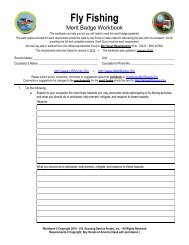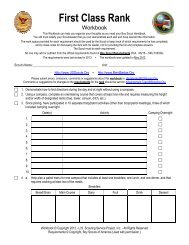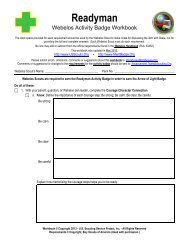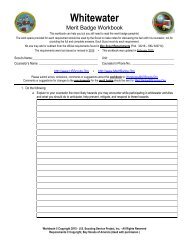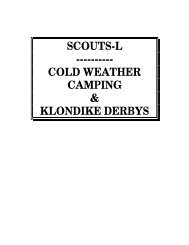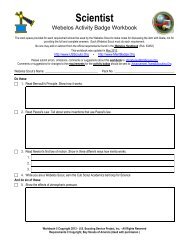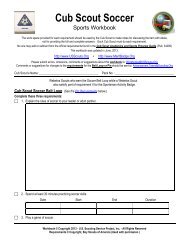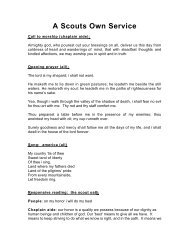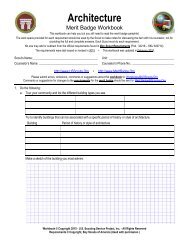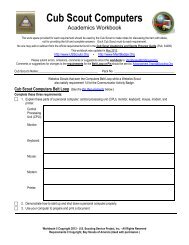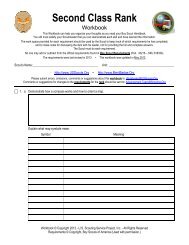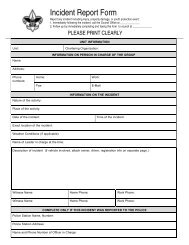BALOO'S BUGLE - US Scouting Service Project
BALOO'S BUGLE - US Scouting Service Project
BALOO'S BUGLE - US Scouting Service Project
You also want an ePaper? Increase the reach of your titles
YUMPU automatically turns print PDFs into web optimized ePapers that Google loves.
Page 2Advisory:Air:Weather Words<strong>BALOO'S</strong> <strong>BUGLE</strong>(from www.weatherwizkids.com)A forecast issued by the National Weather <strong>Service</strong> to highlight conditions that require caution but arenot thought to be immediately life threatening.The mixture of gases which form the atmosphere of the Earth.Air Pressure: The weight of air pressing down on earth. Air pressure can change from place to place, and this causes airto move, flowing from areas of high pressure toward areas of low pressure. It’s the same as barometricpressure.Almanac: A calendar that uses astronomical information and weather data. Almanacs list tide data, give thepositions of the stars and forecast weather each day.Anemometer: A weather instrument that measures the wind speed.Anticyclone: A high-pressure system that moves in a clockwise motion. These bring you sunny skies.Arctic Air: An air mass that originates over Canada and brings us cold temperatures.Atmosphere: A layer of gases surrounding a planet. The Earth’s atmosphere is divided into five layers: exosphere,thermosphere, mesosphere, stratosphere, and troposphere.Barometer: An instrument that measures air pressure.Barometric Pressure: The same as air pressure. The pressure exerted by the atmosphere at a given point.Blizzard: An intense winter storm with winds of 35 mph. or higher with falling and/or blowing snow to reducevisibility below ¼ mile for at least three hours.Breeze:A light wind.Ceiling:The height of the lowest layer of broken or overcast cloud layer.Cirrus Clouds: Thin, wispy clouds that form high in the atmosphere as their water vapor freezes into ice crystals. Cirrusclouds are a principal cloud type.Clear Sky: When the sky has no clouds.Clouds:A visible collection of tiny water droplets or, at colder temperatures, ice crystals floating in the airabove the surface. Clouds come in many different sizes and shapes. Clouds can form at ground level,which is fog, at great heights in the atmosphere, and everywhere in between. Clouds offer importantclues to understanding and forecasting the weather.Cold Front: A boundary between two air masses, one cold and the other warm, moving so that the colder air replacesthe warmer air.Condensation: The change of water vapor to liquid water, as when fog or dew forms.Coriolis Force: A force that deflects moving objects to one side because of the Earth’s rotation. The object is still goingstraight but the Earth moves underneath it, making it look like it is moving to one side. In the NorthernHemisphere, the Coriolis Force deflects objects to the right.Cumulonimbus: A dense and vertically developed cloud that produces thunderstorms. The cloud can bring heavy showers,hail, lightning, high winds and sometimes tornadoes.Cumulus Clouds: Fluffy, mid-level clouds that develop in towering shapes and signal fair weather. Cumulus clouds are aprincipal cloud type.Cyclone:A low pressure system. It is a term variously applied to tornadoes, waterspouts, dust storms, hurricanesand even to any strong wind.Dew:Water that forms on objects close to the ground when its temperature falls below the dew point of thesurface air.Dew Point: The temperature at which water starts to condense out of a particular air mass. The dew pointtemperature changes only when the moisture content of the air changes. The higher the dew point, thegreater the moisture content is in the air.Disturbance: A low pressure system, a tropical area of storminess, or any area in which the weather is in a state ofcloudiness, precipitation or wind.Drizzle:Light rain consisting of water droplets that are very small.



